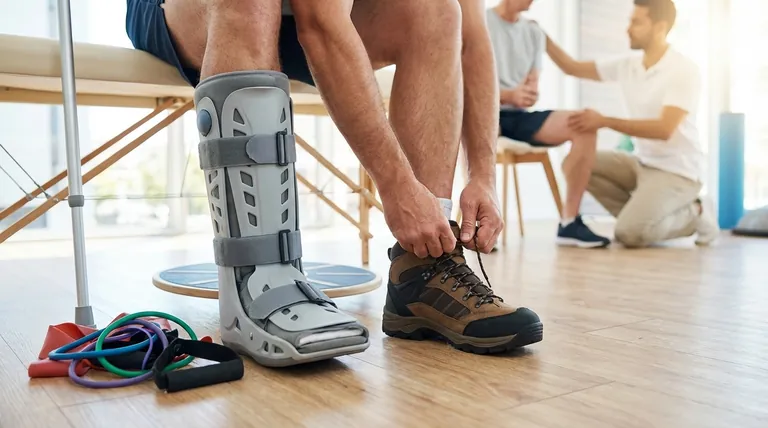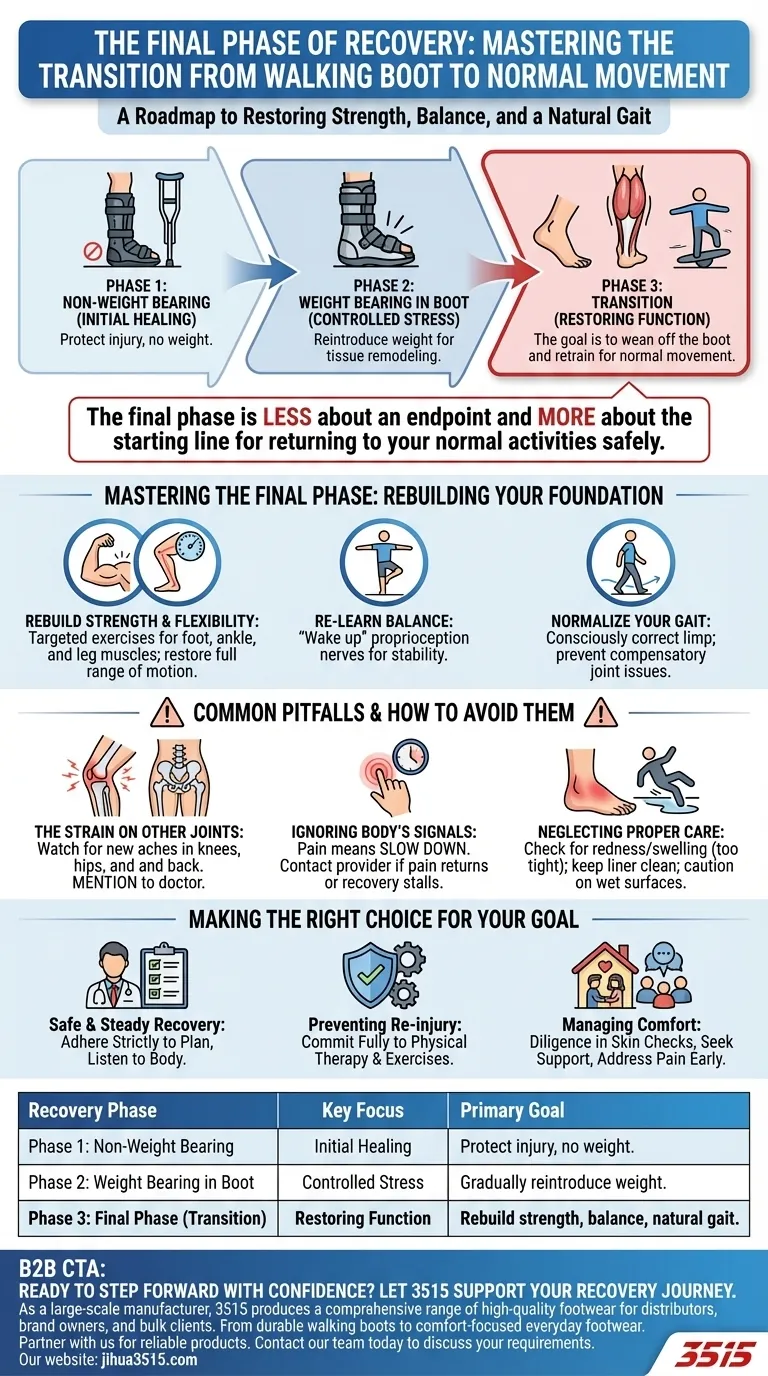The final phase of recovery with a walking boot marks the critical transition from protected healing to unsupported, normal movement. This stage is defined not by simply taking the boot off, but by a focused effort to restore strength, balance, flexibility, and a natural walking pattern to the injured limb.
The walking boot is a temporary tool for healing; true recovery is an active process of rebuilding function. The final phase is less about an endpoint and more about the starting line for returning to your normal activities safely and confidently.

Understanding the Full Recovery Journey
A walking boot is part of a structured, multi-phase recovery plan. Understanding these stages provides a clear roadmap and helps manage expectations for a complete return to function.
Phase 1: Non-Weight Bearing
For severe injuries or post-surgery, the initial phase may involve wearing the boot while using crutches, keeping all weight off the injured limb. This allows the primary healing process to begin without disruption.
Phase 2: Weight Bearing in the Boot
As healing progresses, your doctor will permit you to gradually put weight on your foot while still wearing the boot. This reintroduces controlled stress, which is essential for bone and soft tissue remodeling.
Phase 3: Transitioning to Normal Walking
This is the final and most active phase. The goal is to wean yourself off the boot and retrain your body for normal movement, focusing on the key areas required for stability and mobility.
Mastering the Final Phase: Rebuilding Your Foundation
Successfully transitioning out of the boot requires deliberate focus on specific physical goals. This is where physical therapy is often essential to ensure a full and correct recovery.
Rebuilding Strength and Flexibility
Immobilization leads to muscle atrophy and joint stiffness. This phase concentrates on targeted exercises to rebuild the muscles in your foot, ankle, and lower leg, while also restoring your ankle's full range of motion.
Re-learning Balance
Your body's sense of balance (proprioception) is significantly dulled after being in a boot. Specific exercises are needed to "wake up" the nerves and muscles responsible for keeping you stable on your feet.
Normalizing Your Gait
Walking in a boot forces an unnatural gait, which can affect your hips, knees, and back. A core goal of this final phase is to consciously correct any limping or compensatory movements to prevent future joint issues.
Common Pitfalls and How to Avoid Them
Navigating recovery involves being aware of potential setbacks. Proactive care and attention to your body's signals are your best defense against complications.
The Strain on Other Joints
The altered mechanics of walking in a boot often place extra stress on the knee, hip, and lower back of both legs. Be mindful of new aches and pains in these areas and mention them to your doctor or physical therapist.
Ignoring Your Body's Signals
Pain is a signal to slow down. If you experience a sharp increase in pain or swelling after transitioning out of the boot, it's a sign you may be progressing too quickly. Contact your healthcare provider if pain returns or recovery stalls.
Neglecting Proper Care
Regularly check your foot for redness or swelling, which may indicate the boot is too tight. Keep the liner clean to prevent skin irritation and be cautious on wet surfaces, as the boot's sole can be slippery.
Making the Right Choice for Your Goal
Your approach to this final phase will determine the quality and speed of your long-term recovery. Tailor your focus to your primary objective.
- If your primary focus is a safe and steady recovery: Adhere strictly to the phased weight-bearing plan provided by your doctor and listen carefully to your body's feedback.
- If your primary focus is preventing re-injury and future problems: Commit fully to the physical therapy exercises designed to restore your strength, balance, and a normal walking pattern.
- If your primary focus is managing daily comfort and well-being: Be diligent with skin checks, seek support from friends or family, and address any compensatory pain in your back or hips early.
Taking an active and informed role in this final stage is the most important step you can take toward a full and lasting recovery.
Summary Table:
| Recovery Phase | Key Focus | Primary Goal |
|---|---|---|
| Phase 1: Non-Weight Bearing | Initial Healing | Protect injury with no weight on the limb. |
| Phase 2: Weight Bearing in Boot | Controlled Stress | Gradually reintroduce weight for tissue remodeling. |
| Phase 3: Final Phase (Transition) | Restoring Function | Rebuild strength, balance, and a natural gait pattern. |
Ready to Step Forward with Confidence? Let 3515 Support Your Recovery Journey.
As a large-scale manufacturer, 3515 produces a comprehensive range of high-quality footwear for distributors, brand owners, and bulk clients. Whether you need durable walking boots for post-injury support or everyday footwear designed for comfort and stability, our production capabilities encompass all types of shoes and boots to meet your needs.
Partner with us to provide your customers with reliable products that aid in safe recovery. Contact our team today to discuss your requirements and discover how we can support your business.
Visual Guide

Related Products
- Safety Footwear Wholesale Manufacturer for Custom OEM/ODM Production
- Premium Grain Leather Safety Boots for Bulk Supply
- Premium Wholesale Wheat Nubuck Safety Boot with Rapid Lacing System
- Customizable Anti-Smash Safety Boots for Wholesale & Private Label Manufacturing
- Custom Wholesale Leather Safety Boots Direct Factory Manufacturing
People Also Ask
- What cultural and environmental considerations are tied to wearing shoes indoors? Balance Hygiene, Tradition, and Foot Health
- What are the cultural perspectives on wearing shoes in the house? A Guide to Home Etiquette & Hygiene
- Is it normal to wear shoes in the house? A Guide to Hygiene, Comfort & Culture
- How long can you wear safety boots? The Lifespan is Determined by Wear, Not Time
- What do heavy duty boots do? Protect Your Feet in Demanding Work Environments



















